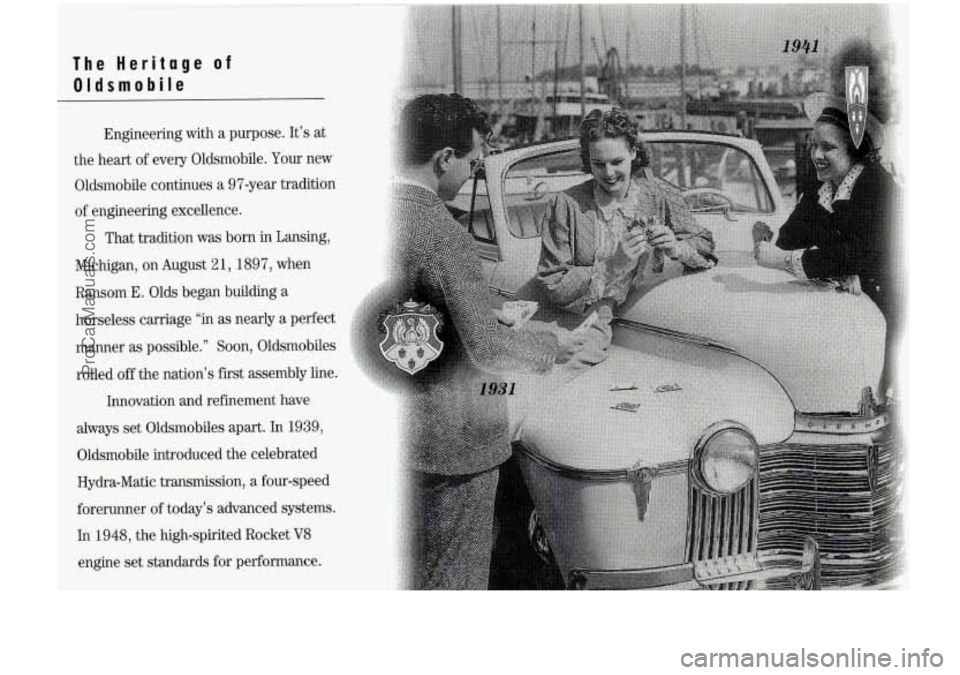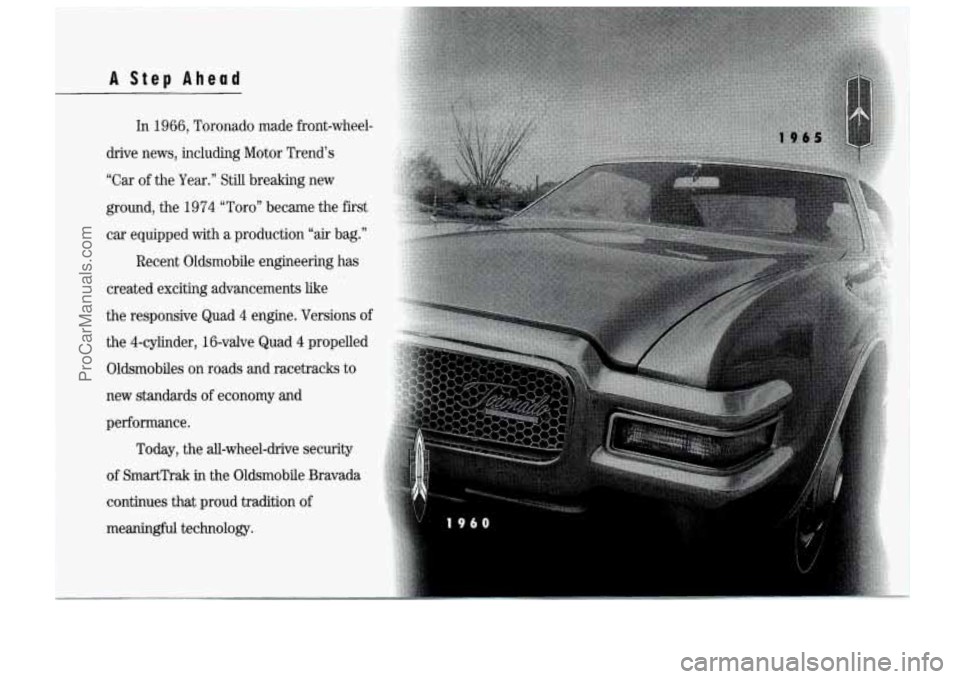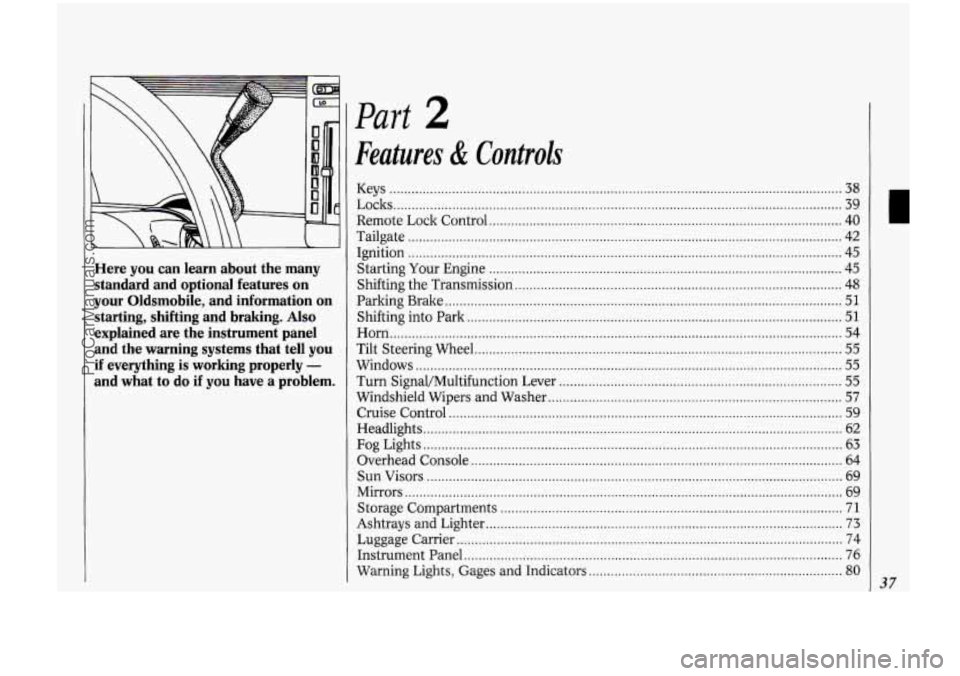engine OLDSMOBILE BRAVADA 1994 Owners Manual
[x] Cancel search | Manufacturer: OLDSMOBILE, Model Year: 1994, Model line: BRAVADA, Model: OLDSMOBILE BRAVADA 1994Pages: 248, PDF Size: 14.54 MB
Page 9 of 248

The Heritage of
Oldsmobile
Engineering with a purpose. It’s at
the heart
of every Oldsmobile. Your new
Oldsmobile continues a 9 7-year tradition
of engineering excellence.
That tradition was born in Lansing,
Michigan, on August
2 1, 1897, when
Ransom
E. Olds began budding a
horseless carriage “in as nearly a perfect
manner
as possible.” Soon, Oldsmobiles
rolled
off the nation’s first assembly line.
Innovation and refinement have
always set Oldsmobiles apart. In 1939,
Oldsmobile introduced the celebrated
Hydra-Matic transmission, a four-speed
forerunner
of today’s advanced systems.
In 1948, the high-spirited Rocket
V8
engine set standards for performance.
ProCarManuals.com
Page 10 of 248

A Step Ahead
In 1966, Toronado made front-wheel-
drive news, including Motor Trend’s
“Car
of the Year.” Still breaking new
ground, the 1974 “Toro” became the first
car equipped with a production “air bag.”
Recent Oldsmobile engineering has
created exciting advancements like
the responsive Quad 4 engine. Versions
of
the $-cylinder, 16-valve Quad 4 propelled
Oldsmobiles on roads and racetracks to
new standards
of economy and
performance. Today, the all-wheel-drive security
of SmartTrak in the Oldsmobile Bravada
continues that proud tradition
of
meaningful technology.
ProCarManuals.com
Page 12 of 248

How to Use this Manual
MANY PEOPLE READ THEIR OWNER’S
manual from beginning to end when
they first receive their new vehicle.
This
vvlll help you learn about the
features and controls for your vehicle.
In
this manual, you’ll find that
pictures and words work together
to explain things quickly.
There are nine parts with thumb-
tabbed pages
in this manual.
Each part begins with
a brief list of
contents,
so you can usually tell at a
glance if that part contains the
information you want.
You can bend the manual slightly to
reveal the tabs that help you find
a
part.
6
Part 1: Seats & Restraint Systems
This part tells you how to use your
seats and safety belts properly.
Part 2: Features & Controls
This part explains how to start and
operate your Oldsmobile.
Part 3: Comfort Controls & Audio Systems
This part tells you how to adjust the
ventilation and comfort controls and
how to operate your audio system.
Part 4: Your Driving and the Road
Here you’ll find helpful information
and tips about the road and how to
drive under different conditions.
Part 5: Problems on the Road
This part tells you what to do if you
have
a problem while driving, such as
a flat tire or engine overheating.
ProCarManuals.com
Page 16 of 248

How to Use this Manual
These symbols are on some of your
controls: These symbols
are used on warning
and indicator lights: Here
are some other symbols you
may see:
Windshield Wipers
Engine Coolant
Temperature Fuse
w Windshield
Washer
Battery Charging
System Tailgate Window
Windshield Defroster Lighter
Fuel
Rear Window Defogger Horn
Speaker
Engine
Oil Pressure
Rear Window Wiper
Brake
Hood Release
Rear Window
WiperlWasher Anti-Lock Brakes
Ventilating Fan
Power Window
10
ProCarManuals.com
Page 43 of 248

Here you can learn about the many standard and optional features on
your Oldsmobile. and information on
starting. shifting and braking
. Also
explained are the instrument panel
and the warning systems that tell you
if everything is working properly -
and what to do if you have a problem .
Part 2
Features & Controls
Keys ........................................................................\
.......................................... .. ....... 38
Locks ........................................................................\
.................................................. 39
Remote Lock Control
........................................................................\
........................ 40
Tailgate ........................................................................\
.............................................. 42
Ignition ........................................................................\
.............................................. 45
Starting Your Engine ........................................................................\
........................ 45
Shifting the Transmission ........................................................................\
................. 48
Parking Brake ........................................................................\
.................................... 51
Shifting into Park ........................................................................\
.............................. 51
Horn ........................................................................\
................................................... 54
Tilt Steering Wheel ........................................................................\
............................ 55
Windows ........................................................................\
............................................ 55
Turn Signal/Multifunction Lever ........................................................................\
..... 55
Windshield Wipers and Washer ........................................................................\
........ 57
Cruise Control ........................................................................\
................................... 59
Headlights
........................................................................\
.......................................... 62
Fog Lights ........................................................................\
.......................................... 63
Overhead Console
........................................................................\
............................. 64
Sun Visors
........................................................................\
......................................... 69
Mirrors
........................................................................\
............................................... 69
Storage Compartments
........................................................................\
..................... 71
Ashtrays and Lighter
........................................................................\
......................... 73
Luggage Carrier ........................................................................\
................................. 74
Warning Lights, Gages and Indicators
..................................................................... 80
Instrument Panel ........................................................................\
............................... 76
37
ProCarManuals.com
Page 51 of 248

U
Ignition Switch
With the ignition key in the ignition
switch, you can turn the switch to five
positions:
Accessory: An “on7’ position in which
you can operate your electrical power
xcessories. Press in the ignition switch
2s you turn the top of it toward you.
Lock: The only position in which you
:an remove the key. This locks your
steering wheel, ignition and
transmission.
Off: Unlocks the steering wheel,
ignition, and transmission, but does not
send electrical power to any accessories.
Use this position if your vehicle must be
pushed or towed, but never try to push-
start your vehicle. A warning chime will
sound if you open the driver’s door
when the ignition is off and the key is in
the ignition.
Run: An “on” position to which the
switch returns after you start your
engine and release the switch. The
switch stays in the
Run position when
the engine is running. But even when
the engine
is not running, you can use
Run to operate your electrical power
accessories, and to display some
instrument panel warning lights.
Start: Starts the engine. When the
engine starts, release the key. The
ignition switch will return to
Run for
normal driving.
Note that even if the engine is not
running, the positions
Accessory and
Run are “on” positions that allow you
to operate your electrical accessories,
such as the radio.
NOTICE:
If your key seems stuck in Lock
and you can’t turn it, be sure it is
all the way in.
If it is, then turn the
steering wheel left and right while
you turn the key hard. But turn the
key only with your hand. Using a
tool to force it could break the key
or the ignition switch. If none of
this works, then your vehicle needs
service.
Starting Your Engine
Move your shift lever to P (Park) or
N (Neutral). Your engine won’t start in
any other position
- that’s a safety
feature. To restart when you’re already
moving, use
N (Neutral) only.
NOTICE:
Don’t try to shift to P (Park) if your
Oldsmobile is moving. If you do,
you could damage the transmission.
Shift to
P (Park) only when your
vehicle is stopped.
45
ProCarManuals.com
Page 52 of 248

Features & Controh
46
1. Without pushing the accelerator
pedal, turn your ignition key to
Start.
When the engine starts, let go of the
key. The idle speed will go down as
your engine gets warm.
NOTICE:
Holding your key in Start for longer
than
15 seconds at a time will cause
your battery to be drained much
sooner. And the excessive heat can
damage your starter motor.
2. If it doesn’t start right away, hold your
key in
Start. If it doesn’t start in three
seconds, push the accelerator pedal
about one-quarter of the way down for
12 more seconds, or until it starts,
3. If your engine still won’t start (or
starts but then stops), it could be
flooded with too much gasoline. Try
this: Wait
15 seconds to let the
starter motor cool down. Then push
your accelerator pedal all the way to
the floor. Hold it there. Then,
hold
the key in Start for no more than ten
seconds. This clears the extra
gasoline from the engine. If
the engine still doesn’t start, wait
another
15 seconds and do it all again.
When the engine starts, let go of the
key and the accelerator pedal.
NOTICE:
Your engine is designed to work
with the electronics in your vehicle.
If you add electrical parts or
accessories, you could change the
way the fuel injection system
operates. Before adding electrical
equipment, check with your dealer.
If
you don’t, your engine might not
perform properly. If you ever have
to have your vehicle towed, see the
part of this manual that tells how to
do it without damaging your
vehicle. See
Towing Your Truck in
the
Index.
Driving llzrough Deep
Standing Water
NOTICE:
If you drive too quickly through
deep puddles or standing water,
water can come in through your
engine’s air intake and badly damage
your engine. If you can’t avoid deep
puddles or standing water, drive
through them very slowly.
ProCarManuals.com
Page 53 of 248

Engine Coolant Heater (Engine
Block Heater)
(OPTION)
In very cold weather, 0°F (-18°C) or
colder, the engine coolant heater can
help.
You’ll get easier starting and
better fuel economy during engine
warm-up. Usually, the coolant heater
should be plugged in a minimum of four
hours prior to starting your vehicle.
To use the coolant heater:
1. Turn off the engine.
2. Open the hood and unwrap the
3. Plug it into a normal, grounded 110-
electrical cord.
volt outlet.
NOTICE:
After you’ve used the coolant
heater, be sure to store the cord as
it was before to keep it away from
moving engine parts. If you don’t, it
could be damaged. How long
should you keep the coolant
warmer plugged in? The answer
depends on the weather, the kind of oil
you have, and some other things.
Instead of trying to list everything here,
we ask that you contact an Oldsmobile
dealer
in the area where you’ll be
parking your vehicle. The dealer can
give you the best advice for that
particular area. I
ProCarManuals.com
Page 54 of 248
![OLDSMOBILE BRAVADA 1994 Owners Manual Features & Controls
48
Automatic Transmission
There are several different positions for
your shift lever.
Park P
Reverse R
Neutral N
Overdrive ID]
Drive D
Second 2
First 1
Park
P (Par OLDSMOBILE BRAVADA 1994 Owners Manual Features & Controls
48
Automatic Transmission
There are several different positions for
your shift lever.
Park P
Reverse R
Neutral N
Overdrive ID]
Drive D
Second 2
First 1
Park
P (Par](/img/31/58197/w960_58197-53.png)
Features & Controls
48
Automatic Transmission
There are several different positions for
your shift lever.
Park P
Reverse R
Neutral N
Overdrive ID]
Drive D
Second 2
First 1
Park
P (Park): This loclts your rear wheels.
It’s the best position to use when you
start your engine because your vehicle
can’t move easily.
ProCarManuals.com
Page 55 of 248

Reverse
R (Reverse): Use this gear to back up.
NOTICE:
Shifting to R (Reverse) while your
vehicle is moving forward could
damage your transmission. Shift
to
R (Reverse) only after your vehicle
is stopped.
To rock your vehicle back and forth to
get out
of snow, ice or sand without
damaging your transmission, see the
Index under If You”re Stuck: In Sand,
Mud, Ice
or Snow.
Neutral
N (Neutral): In this position, your
engine doesn’t connect with the wheels.
To restart when you’re already moving,
use
N (Neutral) only.
NOTICE:
Damage to your transmission
caused
by shifting out of P (Park)
or N (Neutral) with the engine
racing isn’t covered by your
1 warranty.
49
ProCarManuals.com